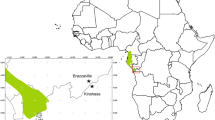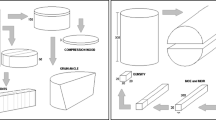Abstract
Key message
Stem guying to prevent wind-induced swaying of radiata pine trees resulted in significant changes in radial growth, but did not affect the frequency of compression wood or resin features.
Abstract
Mechanical stress resulting from wind forces acting on trees can cause a number of direct and indirect effects ranging from microscopic changes in cambial activity through to stem breakage and uprooting. To better understand these effects on radial stem growth and wood properties, an experiment was established in a 13-year-old radiata pine (Pinus radiata D Don) stand in which 20 trees were guyed to prevent them from swaying. Radial growth was monitored in these trees and 20 matched controls at monthly intervals for 5 years. The trees were then felled and radial growth, resin features and compression wood were assessed on cross-sectional discs taken at fixed locations up the stem. There was a significant reduction in radial growth at breast height (1.4 m above the ground) in the guyed trees, but an increase in growth immediately above the guying point. A total of 277 resin features were observed in the growth rings formed following guying. The overall frequency of such features was related to height within the stem and annual ring number. No effect of stem guying was found on the incidence of compression wood. Interestingly, the distribution of resin features also did not differ between guyed and un-guyed trees. There was no evidence of a link between stem restraint as a result of guying and the incidence of resin features, suggesting that other factors, such as soil moisture may be more influential.







Similar content being viewed by others
References
Bannan MW, Bindra M (1970) The influence of wind on ring width and cell length in conifer stems. Can J Bot 48:255–259
Bascuñán A, Moore JR, Walker JCF (2006) Variations in the dynamic modulus of elasticity with proximity to the stand edge in radiata pine stands on the Canterbury Plains, New Zealand. NZ J For 53(1):4–8
Bruchert F, Gardiner B (2006) The effect of wind exposure on the tree aerial architecture and biomechanics of sitka spruce (Picea sitchensis, Pinaceae). Am J Bot 93(10):1512–1521
Burton JD, Smith DM (1972) Guying to prevent wind sway influences loblolly pine growth and wood properties. US Department of Agriculture, Forest Service, Southern Forest Experiment Station Research Paper SO-80, New Orleans, p 8
Clifton NC (1969) Resin pockets in Canterbury radiata pine. NZ J For 14(1):38–49
Cown DJ (1973a) Effects of severe thinning and pruning treatments on the intrinsic wood properties of young radiata pine. NZ J For Sci 3:379–389
Cown DJ (1973b) Resin pockets: their occurrence and formation in New Zealand forests. NZ J For 18(2):233–251
Cown DJ (1974) Comparison of the effects of two thinning regimes on some wood properties of radiata pine. NZ J For Sci 4:540–551
Cown DJ, Donaldson LA, Downes GM (2011) A review of resin features in radiata pine. NZ J For Sci 41:41–60
Daudet F-A, Ameglio T, Cochard H, Archilla O, Lacointe A (2005) Experimental analysis of the role of water and carbon in tree stem diameter variations. J Exp Bot 46(409):135–144
de Shepper V, Steppe K, van Labeke M-C, Lemeur R (2010) Detailed analysis of double girdling effects on stem diameter variations and sap flow in young oak trees. Environ Exp Bot 68:149–156
Dean TJ, Long JN (1986) Validity of constant-stress and elastic-instability principles of stem formation in Pinus contorta and Trifolium pratense. Ann Bot 58:833–840
Dean TJ, Roberts SD, Gilmore DW, Maguire DA, Long JN, O’Hara KL, Seymour RS (2002) An evaluation of the uniform stress hypothesis based on stem geometry in selected North American conifers. Trees 16:559–568
Donaldson LA (1983) Longitudinal splitting of bark: a likely cause of “type 3” resin pockets in Pinus radiata. NZ J For Sci 13:125–129
Eklund L, Sall H (2000) The influence of wind on spiral grain formation in conifer trees. Trees 14:324–328
Frey-Wyssling A (1938) The formation of resin pockets. Holz Roh und Werkstoff 9:329–332
Gjerdrum P, Bernabei M (2007) Three-dimensional model for size and location of resin pockets in stems of Norway spruce. Holz als Roh und Werkstoff 65(3):201–208
Hewitt AE (1998) New Zealand soil classification, 2nd edn. Landcare Research Science Series, Lincoln
Holbrook NM, Putz FE (1989) Influence of neighbors on tree form: effects of lateral shade and prevention of sway on the allometry of Liquidamber styrafaciflua (Sweet gum). Am J Bot 76(12):1740–1749
Jacobs MR (1939) A study of the effects of sway on trees. Commonwealth Forestry Bureau, Canberra
Jacobs MR (1954) The effect of wind sway on the form and development of Pinus Radiata D. Don. Aust J Bot 2:35–51
Jones TG, Downes GM, Watt MS, Kimberley MO, Culvenor DS, Ottenschlaeger M, Estcourt G, Xue J (2013) Effect of stem bending and soil moisture on the incidence of resin pockets in radiata pine. NZ J For Sci 43:10
Kubler H (1991) Function of spiral grain in trees. Trees 5:125–135
Kumar S (2004) Genetic parameter estimates for wood stiffness, strength, internal checking, and resin bleeding for radiata pine. Can J For Res 34(12):2601–2610
Larson PR (1963) Stem form development of forest trees. For Sci Monogr 5:1–42
Larson PR (1965) Stem form of young Larix as influenced by wind and pruning. For Sci 11:412–421
Larson PR (1994) The vascular cambium: development and structure. Springer, Berlin
Lee J (2009) Assessment of the end grain of log ends and discs. Scion Wood Process Newslett 43:5–6
Mattheck C (1991) Trees: the mechanical design. Springer, Berlin
Mattheck C (2000) Comments on “Wind-induced stresses in cherry trees: evidence against the hypothesis of constant stress levels” by K. J. Niklas, H.-C. Spatz, Trees, (2000) 14:230–237. Trees 15:63
McMahon TA (1975) The mechanical design of trees. Sci Am 233:93–102
Meng SX, Lieffers VJ, Reid DEB, Rudnicki M, Silins U, Jin M (2006) Reducing stem bending increases the height growth of tall pines. J Exp Bot 57(12):3175–3182
Metzger C (1893) Der Wind als massgebender Faktor fur das Wachstum der Baume. Mundener forstl Hefte 3:35–86
Morgan J, Cannell MGR (1994) Shape of tree stems––a re-examination of the uniform stress hypothesis. Tree Physiol 14:49–62
Nicholls JWP (1982) Wind action, leaning trees and compression wood in Pinus radiata D.Don. Aust For Res 12:75–91
Niklas KJ, Spatz H-C (2000a) Response to Klaus Mattheck’s letter. Trees 15:64–65
Niklas KJ, Spatz H-C (2000b) Wind-induced stresses in cherry trees: evidence against the hypothesis of constant stress levels. Trees 14:230–237
Park J (2004) The incidence of resin pockets. NZ J For 49(3):32
Pruyn ML, Ewers BJ III, Telewski FW (2000) Thigmomorphogenesis: changes in the morphology and mechanical properties of two Populus hybrids in response to mechanical perturbation. Tree Physiol 20:535–540
Quine CP, Gardiner BA, Coutts MP, Pyatt DG (1995) Forests and wind: management to minimise damage. Forestry Commission Bulletin 114, HMSO, London
R Development Core Team (2013) R: a language and environment for statistical computing. R Foundation for Statistical Computing, Vienna
Rees DJ, Grace J (1980) The effects of wind on the extension growth of Pinus contorta Douglas. Forestry 53:145–153
Riech FP, Ching KK (1970) Infuence of bending stress on wood formation of young Douglas-fir. Holzforschung 24:68–70
Savill PS (1983) Silviculture in windy climates. For Abstr 44(8):473–488
Seifert T, Breibeck J, Seifert S, Biber P (2010) Resin pocket occurrence in Norway spruce depending on tree and climate variables. For Ecol Manage 260(3):302–312
Sellier D, Fourcaud T (2009) Crown structure and wood properties: influence on tree sway and response to high winds. Am J Bot 96(5):885–896
Skatter S, Kucera B (1997) Spiral grain––an adaptation of trees to withstand stem breakage caused by wind-induced torsion. Holz Als Roh-Und Werkstoff 55(4):207–213
Somerville A (1980) Resin pockets and related defects of Pinus radiata grown in New Zealand. NZ J For Sci 10:439–444
Telewski FW (1989) Structure and function of flexure wood in Abies fraseri. Tree Physiol 5:113–121
Telewski FW (1995) Wind-induced physiological and developmental responses in trees. In: Coutts MP, Grace J (eds) Wind and trees. Cambridge University Press, UK, pp 237–263
Telewski FW (2012) Is windswept tree growth negative thigmotropism? Plant Sci 184:20–28
Telewski FW, Jaffe MJ (1986) Thigmomorphogenesis: anatomical, morphological and mechanical analysis of genetically different sibs of Pinus taeda in response to mechanical perturbation. Physiol Plant 66:219–226
Temnerud E (1996) Pitch pockets in Picea abies: variation in amount, number and size within trees and within a stand. Scand J For Res 11:164–173
Temnerud E (1997) Formation and prediction of resin pockets in Picea abies (L.) Karst. Doctoral thesis Acta Universitatis Agriculturae Sueciae Silvestria 26:56
Temnerud E, Valinger E, Sundberg B (1999) Induction of resin pockets in seedlings of Pinus sylvestris L. by mechanical bending stress during growth. Holzforschung 53:386–390
Timell TE (1986) Compression wood in gymnosperms, vol 1–3. Springer-Verlag, Berlin
Tsoumis G (1991) Wood science and technology of wood—structure, properties, utilisation. Chapman & Hall, New York
Valinger E (1992) Effects of wind sway on stem form and crown development of Scots pine (Pinus sylvestris L.). Aust For 55:15–21
Watt MS, Downes GM, Jones T, Ottenschlaeger M, Leckie AC, Smaill SJ, Kimberley MO, Brownlie R (2009) Effect of stem guying on the incidence of resin pockets. For Ecol Manage 258(9):1913–1917
Watt MS, Kimberley MO, Downes GM, Bruce J, Ottenschlaeger ML, Jones TG, Brownlie RK, Leckie AC, Smaill SJ, Xue J (2011) Characterisation of within-tree and within-ring resin-pocket density in Pinus radiata across an environmental range in New Zealand. NZ J For Sci 41:141–150
Wernsdorfer H, Reck P, Seeling U (2002) Mapping and predicting resin pockets in stems of Norway spruce (Picea abies (L.) Karst.). In: Proceedings of the Fourth Workshop IUFRO 50104, Harrison Hot Springs, British Columbia, Canada, September 8–15:68–77
Wilson BF (1968) Effect of girdling on cambial activity in white pine. Can J Bot 46:141–146
Wilson BF, Gartner BL (2002) Effects of phloem girdling in conifers on apical control of branches, growth allocation and air in wood. Tree Physiol 22:347–353
Woollons R, Manley B, Park J (2008) Factors influencing the formation of resin pockets in Pruned radiata pine butt logs from New Zealand. NZ J For Sci 38(2–3):323–334
Zhu J, Liu Z, Li X, Matsuzaki T, Gonda Y (2004) Review: effects of wind on trees. J For Res 15:153–160
Author contribution statement
JRM was the primary author and analysed most of the data. DJC and RBMcK collected data on resin features and contributed to the interpretation of results. JRL arranged the collection of discs, undertook preliminary analysis of the data and assisted with an early draft of the manuscript. RKB assisted with monitoring of the trial, collection and photographing of the discs. TGJ helped with developing the initial trial design and collected data on tree growth during the guying period. GMD and JRM conceived the initial concept of the trial, developed the work plan and obtained funding.
Acknowledgments
Funding for the initial establishment of this experiment was provided by the Wood Quality Initiative Ltd. Future Forests Research Ltd. provided funding for the ongoing data collection, felling of the trial and analysis of the data. Rayonier | Matariki Forests provided the site for this experiment. Scion colleagues Mark Miller and Kane Fleet installed the guying cables and with Jason Bennett assisted in the felling of the trial. Dr Charles Sabatia provides assistance with the analysis of the growth response data. Dr Damien Sellier, Dr Jonathan Harrington and two anonymous reviewers provided helpful comments on earlier versions of the manuscript.
Conflict of interest
The authors declare that they have no conflict of interest.
Author information
Authors and Affiliations
Corresponding author
Additional information
Communicated by T. Fourcaud.
Rights and permissions
About this article
Cite this article
Moore, J.R., Cown, D.J., Lee, J.R. et al. The influence of stem guying on radial growth, stem form and internal resin features in radiata pine. Trees 28, 1197–1207 (2014). https://doi.org/10.1007/s00468-014-1030-1
Received:
Revised:
Accepted:
Published:
Issue Date:
DOI: https://doi.org/10.1007/s00468-014-1030-1




